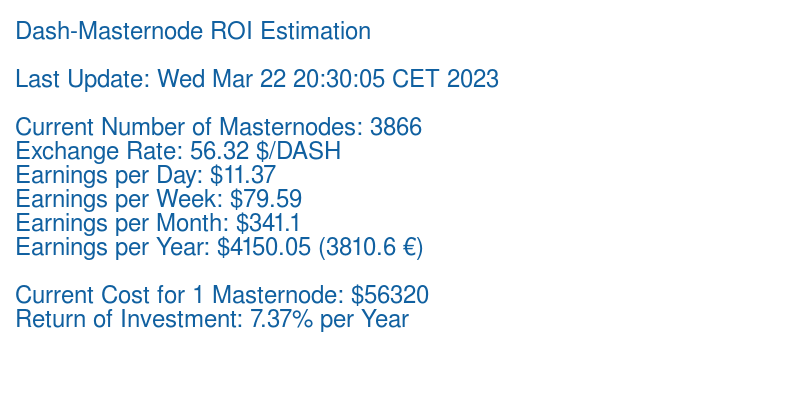In the height of the cryptocurrency boom of later 2017, masternodes emerged as one of the best ways to earn passively from cryptocurrencies. Six years later and it appears no one is talking about masternodes. Relatively newer concepts like DeFi lending and non-fungible tokens (NFTs) have taken center stage.
You may be wondering if running a masternode is still profitable in 2023. In this article, we explore the current state of the masternode market and the profitability of hosting one.
What is a Masternode?
A masternode is essentially a server on a decentralized blockchain network that performs special functions such as enabling instant and private transactions, voting, governance, etc. While the core functions of a masternode vary from one blockchain network to another, this category of nodes is typically used in tandem with Proof-of-Stake (PoS) or Proof-of-Work (PoW) algorithms.
To learn more about masternodes, check out our Masternode 101 article.
As a rule of thumb, operating a masternode requires a substantial amount of the said masternode cryptocurrency as collateral. This collateral can range from $450 for cryptocurrencies like Horizen to as high as $59,000 for coins like DASH. Irrespective of the amount, masternode operators are rewarded with additional cryptocurrency in exchange for their services. And this is where the passive income comes from.
Is hosting a masternode still profitable?
Now, to the elephant in the room – is running a masternode still profitable in 2023? The short answer is yes. However, I must warn you. Operating a masternode is definitely not the fastest way to double or even triple your investments in crypto.
The amount earned by Masternode operators usually falls within the range of 5% to 20% of the block reward, which is dependent on the cryptocurrency being supported.
Using Dash as the first case study, you will need 1,000 DASH tokens to deploy a masternode. As of March 22, 2023, DASH was priced at $56.32, meaning it will cost you about $56,320 to own a masternode on the DASH network. Data on the Dash Masternode Guide reveals that there are currently 3,866 masternode operators on the network.
The guide also pegs the annual ROI at 7.37%, translating to $11.37 daily, $341.1 monthly, or $4,150 yearly.

Alternatively, you will need 25,000 WGR tokens (or about $110) to deploy a masternode on the Wagerr network. Although the cost of setup is significantly lower than that of Dash, the network offers higher masternode rewards. The annual ROI is 9.87% or $11.87.
In both scenarios, you’d be generating some passive income from running a masternode. All things being equal, you would have earned some extra tokens in the form of rewards by doing almost nothing. However, imagine the time it would take you to double your initial $56,000 investment in a Dash masternode. The bottom line is that hosting a masternode is a great way to put idle funds to work.
Top 4 masternode coins worth checking out
As of March 2023, there were about 100 active cryptocurrency projects offering masternodes. We’ve curated a list of our top picks for masternode projects in 2023.
Syscoin (SYS)
Currently one of the more expensive masternodes, Syscoin launched as a fork of the Bitcoin protocol in 2014. In addition to masternodes, the layer one blockchain uses a hybrid consensus mechanism that combines proof-of-work (PoW) and proof-of-stake (PoS) algorithms to validate transactions and maintain the blockchain.
Operating a Syscoin masternode will set you back by about $18,000 (100,000 SYS tokens). While this is a significant amount for most retail investors, the ROI is about 7.6% annually.
As of March 2023, there were over 2,500 active masternodes, which accounted for about 36.2% of the total token supply. Syscoin offers a specialized incentive model with seniority benefits and claims that its network of masternodes is resilient against price fluctuations.
At current market prices, you will earn approximately $26 weekly or $1,377 annually for deploying a Syscoin masternode. Furthermore, 75% of each regular block reward is distributed to masternode operators as an incentive to continue operating the node. Each payout amounts to roughly 55 SYS.
Horizen (ZEN)
Previously known as ZenCash, Horizen is a privacy-centric blockchain built on top of the Zcash protocol, which is known for its advanced privacy features. The protocol offers a number of key features such as a private messenger (ZenChat), anonymous publishing platform (ZenPub), dApps development platform (Horizen Labs), Sidechains, and a TOR-like domain fronting service (ZenHide).
Speaking of its masternode service, aka ZenNodes, Horizen currently has the highest number of deployed nodes. The platform has a multi-tiered node structure, a Secure Node that requires 42 ZEN and a Super Node that requires 500 ZEN.
There are presently over 37,000 active Secure Nodes and nearly 4,100 Super Nodes. While the Secure Node cost approximately $440 to deploy, a Super Node is about $5,200. The annual ROIs on both tiers are 8% and 6% for a Secure Node and a Super Node, respectively.
Dash (DASH)
This list will not be complete without the pioneer of the masternode concept. Created in 2014 with the goal of being a fast and easy-to-use digital currency for everyday transactions, Dash, and by extension, its founder Evan Duffield is the brain behind masternodes.
Dash masternodes act as a second layer of infrastructure on the network, providing additional security and speed to the transaction processing system. It is also worth adding that Dash is the most expensive masternode in the crypto space, priced at over $60,000. However, this high price tag does not translate to a higher ROI, as you may receive an annual ROI of just 5.39%.
DeFiChain (DFI)
Touted as a “native decentralized finance for Bitcoin,” DeFiChain is interested in making fast, intelligent, and transparent decentralized financial services accessible to everyone.
Creating a masternode on DeFiChain is essential to partake in the consensus protocol and earn staking rewards. This will however cost you 20,000 DFI tokens (or $11,273).
DeFiChain offers two distinct masternode roles – the ‘masternode owner’ and the ‘masternode operator.’ The owner is responsible for holding the collateral, while the operator primarily carries out activities such as minting new coins and voting for anchors.
The protocol has quite a high ROI of around 47% annually, equivalent to $5,400.
Should I invest in masternodes?
Looking at the numbers, it is obvious that operating a masternode is a long-term investment. If you are looking to quickly double or triple your initial investment, them masternodes are not for you. While they provide a passive source of crypto income, setting up and configuring a masternode server requires an initial investment and typically involves staking a significant amount of collateral to run the node.
In addition to the initial investment, there is also a technical aspect to running a masternode. You will need to configure and host the node, which can be time-consuming and costly. However, there are several third-party providers that offer masternode setup services, such as Allnodes and others, making it easier than ever to set up and run a masternode.





